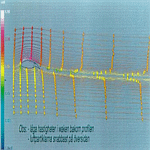 |
 |
| Trailing vortices and downwash phenomenon of an aircraft in flight are seen clearly in this figure. In this situation, a Cessna Citation VI was flown immediately above the fog bank over Lake Tahoe at approximately 313 km/h or 170 knots (B. Budzowski, Director of Flight Operations, Cessna Aircraft Company, private communication, 1993). Aircraft altitude was about 122 m (400 ft) above the lake, and the weight was approximately 8400 kg. As the trailing vortices descended over the fog layer due to the downwash, the flow field in the wake was made visible by the distortion of the fog layer. The photo was taken by P. Bowen for the Cessna Aircraft Company from the tail gun- ner's position in a B-25 flying in formation slightly above and ahead of the Cessna. The aircraft is seen initiating a gentle climb after a level flight, leaving a portion of the fog layer yet unaffected. The wing span measured 16.3 m and the wing area was 29 m^2. The Reynolds number based on the mean aerodynamic chord of 2.1 m was 1.1x10^7. Extract from the Gallery of Fluid Motion, Physics of Fluids A, Vol. 5, September 1993. Contribution by Hiroshi Higuchi (Syracuse University). Photo courtesy of Cessna Aircraft Company. |
| "More than anything else the sensation is one of perfect peace mingled with an excitement that strains every nerve to the utmost, if you can conceive of such a combination." — Wilbur Wright |
 |
| Fluid simulation from SAAB Aircraft shows phase lag between upper and lower air parcels after an airfoil has passed. Air travels much faster over the top of the airfoil, and then it never rejoins the air which has travelled below. Note that the airfoil has deflected the air downwards. |
 |
| On a clear day, trailing vortices are often seen in the sky following the passage of an airplane. The vortices are formed because the wing develops lift. That is, the pressure on the top of the wing is lower than on the bottom, and near the tips of the wing this pressure difference causes the air to move around the edge from the bottom surface to the top. This results in a roll-up of the fluid, which then forms the trailing vortex. In the sky, the vortex becomes visible when the air has a high humidity. The velocities inside the vortex can be very high, and the pressure is therefore quite low. Water vapor in the air condenses as water droplets, and the droplets mark the presence of the vortex. In this picture of a cropduster flying near the ground, the vortex is made visible by a red flare placed on the ground. The red smoke is wrapped up by the trailing vortex originating near the tip of the wing. The strength of the vortex is related to the amount of lift generated by the wing, so they become particularly strong in high-lift conditions such as take-off and landing. They also increase in strength with the size of the airplane, since the lift is equal to the weight of the airplane. For a large transport airplane such as a 747, the vortices are strong enough to flip a small airplane if it gets too close. Trailing vortices are therefore the principal reason for the time delay enforced by the FAA between take-offs and landings at airports. Picture courtesy of DANTEC Measurement Technology. |
| Another picture from the 1993 Aviation Week & Space Technology Photo Contest. This came second in the Military catergory, and it was taken by James E. Hobbs, from Lockheed Aircraft service Co., Ontario, California. The plane is ejecting flares during a test of an infrared missile warning and self-protection system installed on a C-130 Hercules. The trailing vortices formed in the wake are clearly visible. The size of these vortices is related to the lift produced by the wings, and the photograph suggests that the aircraft was climbing during this maneuver. |
 |
| Since I will soon be going to Air Force pilot training to learn to fly the F-16. I just think that this is the best picture of an F-16 I have ever seen. Trust me, I have sifted through pages of pictures. Click on the picture for the large version. |